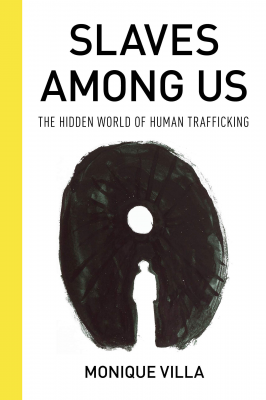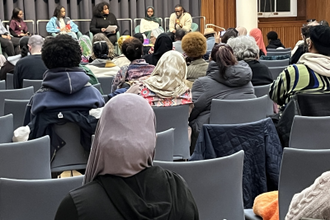Slaves Among Us: The Hidden World of Human Trafficking

Modern slavery touches us all, in the cheap fashion we buy, the minerals used in our phone, the bag of prawns in our freezer, the chocolate we consume, and when we get our car washed or our nails done. By telling the stories of three survivors of human trafficking, Monique Villa illustrates the horrors suffered by an estimated 40 million people worldwide, 25% of whom are children.
The International Labour Organisation estimates human trafficking is worth $150 billion a year. Whereas a slave in the 19th century cost the equivalent of $40,000, the price now is $90, meaning slaves can easily be discarded when they become too ill to work.
Villa describes the conditions endured by 30 million children in Indian factories, working 22 hours a day, sleeping beneath their work stations, and beaten with hammers by factory owners. She tells of a little boy, rescued by an Indian charity, who cannot understand why the NGO staff are nice to him. He asks they are trying to pacify him so they can take his kidneys.
Seventy percent of trafficked people are forced labour or in debt bondage, often tricked into working under the Kafala system in the Arabian Gulf. Their passports are confiscated and their wages withheld or never paid. They live and work in dangerous conditions, and when they return home, they must pay off the money-lenders whom they used to buy their flights. Interest rates of 60% are common, meaning it is impossible to ever repay the debt. The Arabian slave trade pre-dates the Atlantic one, yet not a single Arab academic has published a paper about the Arabs' role in trafficking millions of black Africans over the centuries. The amnesia continues to this day.
An estimated 30% of trafficked people are sex slaves. Virtually all women and girls who are trafficked are raped: violence and domination are key to control, convincing the slave that no one cares about them. Given that 90% of cases, girls have been sold by a family member, this is a likely assumption. Although Villa does not delve into this enough for fear of making sweeping generalisations, there is a clear link between societies in which females are regarded as inferior, and the likelihood women will be bought, sold and mistreated.
In more enlightened societies, traffickers are adept at recognising vulnerability in children in care homes. Villa has hair-raising stories of teachers and social workers in the first world turning a blind eye to the mistreatment of children by their own families, thereby making them vulnerable to grooming by traffickers; or children turning up to school exhausted and covered in bruises, having been sold to men perhaps twenty times during the night. Officials also ignore the tattoos or brands showing which pimp owns the girls. Victims of trafficking are betrayed and made to feel helpless at every stage: no wonder so many become drug addicts.
Human trafficking is not possible without a web of corruption, stretching from flight attendants to immigration officials to police and judges to parole officers to CEOs who refuse to confront the truth about their high profit margins. Legal redress is made difficult by the widespread ignorance of trafficking in the justice system: there are fewer than 15,000 cases against traffickers worldwide annually. Very few men having sex with children are prosecuted, and many tell the girls to their faces that they do not believe they are slaves ("You're just trying to get more money from me").
Evidently, consumers don't wish to acknowledge that their t-shirt has been made by a child slave. Even informing a customer that they are buying slavery-free products induces feelings of guilt and makes them less willing to buy. Yet, Villa concludes, pressuring businesses is one of the best ways forward. She offers practical suggestions for action the reader can take, as well as changes that might make it easier to keep victims from slipping back into slavery.
My only criticism is the lack of insight into the mind of a factory owner who beats a five-year-old with a hammer, or a judge who takes a bribe to ignore evidence of sex trafficking. Perhaps their motivation is no more complicated than greed. No wonder so many of Jesus's parables concerned this human trait.
Following California's example (the Transparency in Supply Chains Act), several other countries have begun to legislate. However, without enforcement, these are mere gestures. Reading this book will leave you feeling disgusted, but hopefully, ready to be a thoughtful and well-informed consumer.
Slaves Among Us - The Hidden World of Human Trafficking by Monique Villa, published by Rowman & Littlefield


















